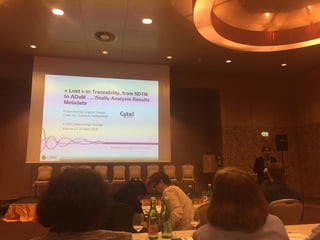The Making of a CDISC Trainer


CDISC is a global, nonprofit charitable organization whose mission is ‘to inform patient care and safety through higher quality medical research’. The organization delivers this mission through the development of data standards designed to streamline clinical research- these standard formats are increasingly expected for use in data submissions by regulatory authorities. Importantly, data standardization also brings significant benefits to the industry- in the CDISC 2014 Business Case (1), it is noted that:
“For those developing regulatory eSubmissions, using updated baseline numbers for the time and cost of getting a drug to market, it can be found that ~ $180M can be saved per submission (18% of the total cost). An average of two years can be saved off of an average 12-year clinical development program lifecycle – just by standardizing data”.
It’s therefore critical that the biopharma and CRO industries develop the next generation of data managers, statisticians and programmers with strong knowledge of the CDISC standards.

Angelo Tinazzi has more than 20 years’ experience in data-management and statistical programming and is Director of Clinical Data Standards and Data Submission at Cytel. He has been a member of the European CDISC Committee since 2015 and is a member of the CDISC ADaM team. Taking the next step in his journey as a data standards expert, Angelo is now a "candidate trainer" with CDISC –working towards becoming an “Authorized CDISC Instructor”. In this blog we find out more from Angelo about his experiences and the role of the CDISC trainer.
What is the role of the CDISC trainer?
.png?width=320&name=ece8e55f-8436-4d0c-922b-0306d0651a23%20(1).png)
So among the CDISC objectives, are to develop the CDISC community and make sure the standards, the guidance and other technical aspects of CDISC are well understood.
On a practical level, the role of the trainer is to run training around the globe in each regional area. The trainer also needs to help develop the training material which is used- this includes presentations along with practical case studies and exercises. To get to this point, there are regular meetings to discuss any updates to standards or the implementation guide which need to be reflected in the training package. Currently, CDASH, SDTM, ADaM and define.xml are the main packages offered to the trainees.
What standard will you be training on?
I am a Candidate trainer for the ADaM standard in Europe. It’s important to note that there aren’t unlimited slots for trainers- you effectively have to wait for a “seat” to become available within your region and put yourself forward. The key is to demonstrate that you have extremely strong experience with the particular standard you are applying for, and preferably that you have been involved in the team working on development of that standard (I have been a member of the CDISC ADaM team for 3 years and I also presented on several occasion on CDISC topics at both CDISC Interchange and PhUSE). So as soon as there is a “seat” available you submit your candidature, you get screened and if you pass the interview with the senior CDISC trainer team members you are part of the ‘crew’.
How is the CDISC training delivered?
In Europe there are public training sessions usually 3-4 times a year, usually including one at the CDISC EU Interchange which is taking place in London this year. It can depend very much on demand as well. It may be that a biopharma company hosts a public training, so in November for example, there was a session held at Actelion in Basel. A company could also potentially ask CDISC to run training for their own employees.

What prompted you to get involved with this initiative?
From a personal point of view, I really enjoy doing these kind of things. I like presenting and coaching for example, and often present at industry conferences such as PhUSE and the CDISC EU Interchange. These training initiatives are of course hugely important for the industry as we work towards better data standardization.
What have you learnt since starting this process?
It’s been very beneficial. As part of the process of becoming a trainer you need to go through the particular standard’s guidance in a very systematic way. When you work through the CDISC training, you also become aware of other important aspects that aren’t necessarily a formal part of the guidance. Finally, you gain a really solid understanding of the rationale behind the standards since the official CDISC training is developed by those who actually worked on their development.
Has it been helpful in your day to day work?
Yes certainly. Having strong and up to date in-house knowledge of CDISC standards is obviously very beneficial. Ensuring that we have strong training skills is also helpful for coaching and development of our global programming team at Cytel.
So what are the next steps?
I conducted my first training as a candidate trainer. The qualification process involves doing 4 such sessions with an authorized CDISC Instructor a before becoming fully qualified. I anticipate this should be completed by 2017. The experience from the first training was very positive and I’m really looking forward to the next one in London at the European Interchange, and ultimately being a part of the global CDISC training team.
Cytel is committed to being part of the global research community, and our people participate extensively in industry initiatives in biostatistics, programming, and data management. To learn more about our supportive company culture and careers with Cytel click below.
References
Further reading
Lost in Traceability: From SDTM to ADaM
CDISC Submissions: Are you up to speed?


